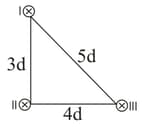Ampere’s Circuital Law
Ampere’s Circuital Law: Overview
This topic covers concepts, such as Magnetic Field Due to a Current-Carrying Cylinder Using Ampere's Law, Magnetic Field Due to a Current-Carrying Hollow Cylinder Using Ampere's Law, Magnetic Ampere's Circuital Law, etc.
Important Questions on Ampere’s Circuital Law
Current I is following along the path ABCD, along the four edges of the cube (figure-a) creates a magnetic field in the centre of the cube of . Find the magnetic field B created at the centre of the cube current I following along the path of the six edges ABCDHEA figure - b
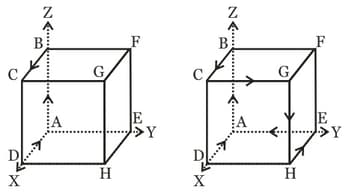
Two long conductors are arranged as shown above to form overlapping cylinders, each of radius r, whose centres are separated by a distance d. Current of density J flows into the plane of the page along the shaded part of one conductor and an equal current flows out of the plane of the page along the shaded portion of the other, as shown. What are the magnitude and direction of the magnetic field at point A ?
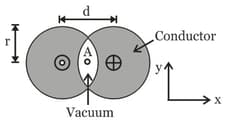
A cylindrical conductor of radius carries a current along its length. The current density , however, is not uniform over the cross-section of the conductor but is a function of the radius according to , where is a constant. Then the expression for the magnetic field

at
at
Six wires of current and cut the page perpendicularly at the points and respectively as shown in the figure. Find the value of integral around the circular path
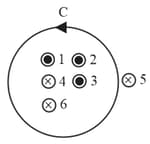
A circuit is in the form of a regular hexagon of side with its centre at the point . A current flows in the circuit.
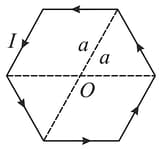
The magnitude of the magnetic field at is
A long hollow cylindrical metal tube has an inner radius and outer radius A current I flows along the length of the tube and is uniformly distributed along the cross section of the tube. The length of the tube is much greater than . If denotes the distance from the axis of the cylinder, then the magnitude of the magnetic field in the hollow part of the tube is approximately
Ampere's law is analogous to
A long straight wire of radius carries a steady current The current is uniformly distributed across its cross-section. The ratio of the magnetic field at is
Choose the incorrect option-
The two ends of non-conducting spring of force constant and unstretched length of are connected to the mid points of two straight parallel rods each of length . When current is passed through each rod in the same direction, the work done on the spring in is
Switch is closed at At time suppose current through the ammeter is then the value of the line integral along the planar loop drawn in the space between the plates of the capacitor parallel to the plates is given as
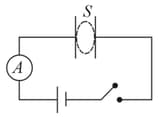
STATEMENT-1: A uniformly distributed direct current flows through a solid long metallic cylinder along its length. The magnetic field produced by this current is only outside the cylinder.
STATEMENT- 2: A thin long cylindrical tube carrying uniformly distributed direct current along its length does not produce a magnetic field inside it. Moreover, a solid cylinder can be supposed to be made up of many thin cylindrical tubes.
Ampere’s circuit law is given by
Ampere circuital equation for given problem is equal to

The statement that "the line integral of the tangential component of the magnetic field strength around a closed path is equal to times the current enclosed by a path" represents
An infinitely long hollow conducting cylinder with inner radius and outer radius carries a uniform current density along its length. The magnitude of the magnetic field, as a function of the radial distance from the axis, is best represented by
Maxwell's modification of Ampere's circuital law is
The figure shown, has three long straight current-carrying conductors having current respectively. Then the value of will be
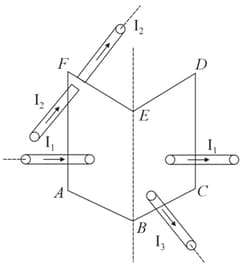
In the diagram shown, a wire carries a current I. What is the value of the (as in Ampere's law) on the helical loop shown in the figure? The integration is done in the sense shown. The loop has N turns and part of the helical loop on which arrows are drawn is outside the plane of the paper.
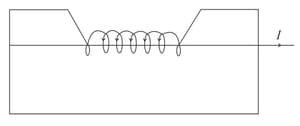
Three long wires, each carrying current are placed parallel to each other. The distance between I and II is 3d, between II and III is 4d and between III and I is 5d. Magnetic field at the position of wire II is

